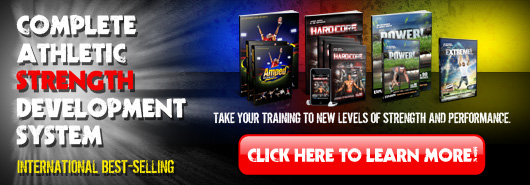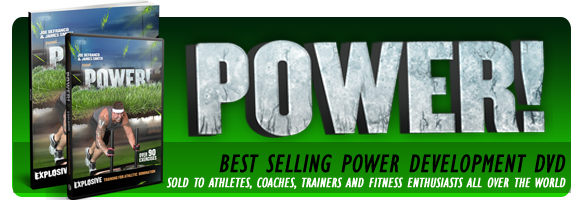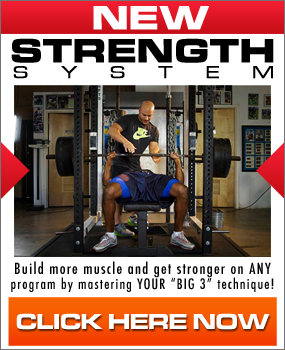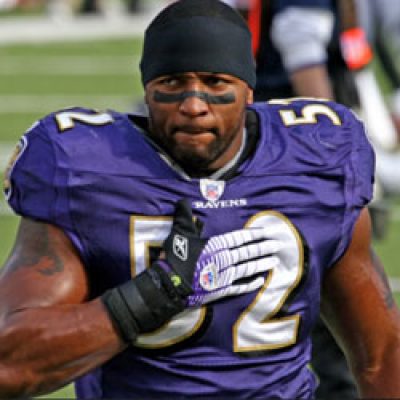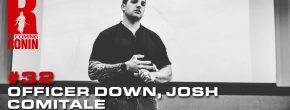Powerlifting Basics

Beginner’s Guide to Powerlifting 101
Author | Jesse Burdick | POWERWOD.com
Here is an amazing powerlifting basics series from elite powerlifter, Jesse Burdick. Jesse is a lifter and coach who has totaled Elite in 3 different weight classes and runs his own very successful facility. Jesse details simple strategies for helping you increase your bench press, squat, and deadlift.
Jesse will be answering our questions about how to get stronger, become more explosive and build more muscle. I thought the easiest way for everyone to learn was to have him film 1-2 minute videos with solutions to the biggest issues lifters face when they try to get stronger with the barbell lifts and learn the fundamentals of powerlifting.
We will start with how to get better at the bench press and dial-in your personal technique.
Powerlifting | How to Bench Press
Problem: Missing Weights at Lockout
In the first installment, Jesse talks about one of the biggest issues most lifters face when trying to build a bigger bench press.
When the bench breaks down at the top of the movement, there are typically 3 possible issues:
1. Tricep Weakness
2. Technique Issue
3. Poor Setup
In the video, Jesse focuses on proper technique at the lockout. Most lifters “press out of their arch” – as I’ve described in great detail before. Jesse calls this “unraveling.” This sets up bad mechanics, potential shoulder issues, and weaknesses.
Once you know not to press out of the “shoulders back and down” position and focus on driving yourself “under the bar”, you’ll be able to keep the bar in a straight path and lock the weights out like a pro.
Powerlifting | How to Bench Press
Problem: Missing Off the Chest
In this second installment, Jesse talks about the second biggest issue facing those chasing a big bench – missing off the chest. If you’ve been benching for a while, you have at one point or time, missed a heavy bench press off the chest. This is typically called getting “stapled” with the weight.
Jesse says it comes down to two things:
1. A setup issue, or
2. A strength issue.
I go into great detail on how to setup in the how to bench press guide, but Jesse also talks about the importance of the:
– foot position
– leg drive
– upper body position
– the arch
– shoulders back and down
– chest up – high chest position
Get a Stronger Back
Jesse also says that bench pressing requires a strong back, shoulders and triceps. You program must include exercises to develop a strong back. Row variations, including bent over rows, chest supported rows, cable rows, and even static holds are all great options. For the end position of the rows, you should focus on holding that end range position and focusing on pulling the shoulder blades back and down while driving the chest up.
Get Stronger Triceps
Jesse states that “bigger arms equals a bigger bench.” He also talks about building tricep mass and strength with extensions and dumbbell bench pressing. Some of my favorite variations for developing the triceps are hitting high volume drop sets with elastic bands and also including close grip bench press for tricep strength.
I would also like to add the importance of warming up for the bench. This is huge for having a great session and recovering much faster. The warm-up is really critical and should never be skipped.
Here is a perfect warm-up sequence that works every time:
Step 1: Foam rolling / lacrosse ball workout ACROSS the chest and upper back. Don’t forget to include movement into foam rolling. Joe DeFranco and I go into great detail with this technique in our certification and latest DVD – Hard:CORE. Check back soon for the new DVD system.
Step 2: Upper back activation and shoulder mobility with any of the following; face pulls, rotator cuff Y, T, W, L, push-up pluses, band retractions, push-ups, and various shoulder stretches. (Reference: AMPED Warm-up)
Step 3: A push/pull combo of any kind; a horizontal or vertical row variations. This is going to engage the right muscles and get them firing the right way. Focus on a controlled tempo and your breathing. Some exercise examples include: push-ups, light db military press, pull-ups, lat pull-downs.
Step 4: Light worksets with the bench press. You can just use the bar, or even just use a really controlled push-up variation.
Step 5: Test the bench to see how it feels. Repeat steps 1-4 as necessary until you are ready to start adding heavier weights on the bar and getting into your worksheets.
\\\\\\\\\\\\\\\\\\\\\\\\\\\\\\\\\\\\\\\\\
\\\\\\\\\\\\\\\\\\\\\\\\\\\\\\\\\\\\\\\\\
\\\\\\\\\\\\\\\\\\\\\\\\\\\\\\\\\\\\\\\\\
\\\\\\\\\\\\\\\\\\\\\\\\\\\\\\\\\\\\\\\\\
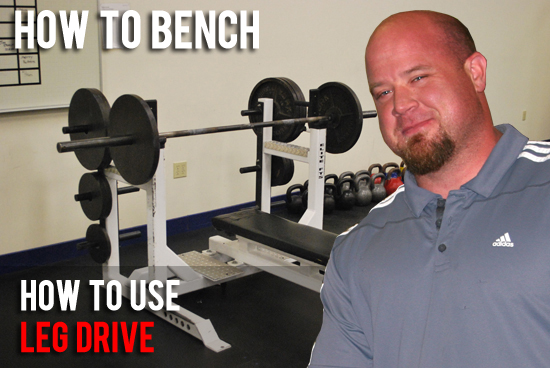
In our continuing series with Jesse Burdick from PowerWOD.com, we tackle one of the most misunderstand aspects of the bench press – leg drive.
Whenever I talk to anyone or instruct a group on how to bench press, I always get puzzled looks when I start talking about leg drive. Even though it is rarely discussed, it really is the key to increasing your bench weights.
Listen carefully as Jesse talks about how important leg drive is and the techniques you can use to improve your leg drive.
Some key points Jesse discusses:
– The leg drive focuses on building up bottom of the bench press.
– It gives you a better platform or foundation to press from (note: remember what we always say, More tension = more strength. The bench press is a full body lift and you need tension in the lower body to improve your overall strength for the drive phase.)
– Wind up hip capsule and drive feet down into the floor. If you’re missing hip mobility, this will affect your leg drive and tension in the lower body. Mobility also impacts your ability to ‘bench off the traps’ and maintain proper thoracic extension while benching.
– Work on a variety of foot positions to find your right spot. Jesse goes over several different techniques for setting up the feet.
Did you miss Jesse’s first two videos?
How to Bench Press -Missing Off the Chest
https://www.dieselsc.com/how-to-bench-missing-off-the-chest/
How to Bench Press -Missing at Lockout
https://www.dieselsc.com/how-to-bench-missing-weights-at-lockout/
In our next installment from Jesse Burdick (PowerWOD.com), Jesse talks about one of the most misunderstood techniques when learning how to deadlift – how to use the lats to finish the movement.
Side Note: To view the entire series, check out the Diesel Training Center
When deadlifting, Jesse first discusses why it is important to use the lats – i.e, keep tension on the lats by actively pulling the bar into you. He also talks about shoulder position and how the shoulders depress, especially during heavy deadlifts.
Benefits of Using the Lats for the Deadlift
1. Keeps the bar close to you – keeping the bar close to the midline is much safer for you and you have a better mechanical. Think of “dragging the bar up” the front of your body.
2. Allows the shoulder girdle to depress – this will ensure you finish with a “chest through” position at the lockout. Allowing your shoulder girdle to depress will also shorten the distance you have to drop to get into position at the start of the movement.
Great Exercise to Properly Engage the Lats
Jesse states that that an old school exercise – the straight arm lat pulldown- is one of the best ways to “feel” how to use the lats properly when you’re deadlifting. I talk about this same technique in a hip hinge video I posted a while ago. I talk about pulling the bar into your legs with an active lat engagement.
Using the Lats for a Big Deadlift

In our next installment from Jesse Burdick (PowerWOD.com), Jesse details probably one of the best tips ever for the deadlift. When you are learning how to deadlift, this crucial technique will improve your pull by leaps and bounds. It takes lifters years to figure this out and Jesse is giving you all of the details in this article, so please listen up.
Side Note: To view the entire series, check out the Diesel Training Center
Taking the Slack Out of the Bar
Jesse defines the “slack” as the distance the bar travels or bends before the weight moves and comes off the ground. Due to the weight on each end of the bar, when a lifter pulls on the middle of the bar, it bends slightly before the weight starts to shift and move upward – this is called ‘the slack’.
Jesse then states that if you take the slack out of the bar correctly, you won’t here the ‘snap’ or clank that is associated with jerking the weight off the floor. Most novice lifters try to explode into the bar and jerk the weight up to try and pull more weight then they should be deadlifting.
When they do this, a lot of stuff goes wrong.
When you jerk the weight too fast or too hard off of the floor, your hips shoot up and you lose your starting position. This is the easiest way for your spine to shoot out and smash into the back wall.
Cleaning Up Your Form and Dominating
The better technique would be for the lifter to lock their torso in place and ‘squeeze’ the weight off the floor by driving the ground away – as if they are performing a leg press. I talked about this technique in a previous article.
If you take the slack out the right way, then everything is “connected together” and you’ll end up in a very good mechanical advantage. Taking the slack out means you are getting the proper pre-tension before loading your hips downward into the starting position. In fact, Jesse states that you should use the bar to “pull yourself down” into the starting position and lock yourself into place. This is huge and a very important tip for you to use in your setup.
More Benefits for Pulling the Slack Out of the Bar
Jesse states that pulling the slack out of the bar will help to:
Benefit #1: Make your deadlift a very efficient movement. Breaking it down to the most fundamental and basic hip extension movement.
Benefit #2: “Pull yourself into position” and pre-tension in the bottom starting position.
Benefit #3: Shorten the range of motion for the entire movement.
Benefit #4: Be in a safer starting position.
Benefit #5: Life more weight – boom!
Benefit #6: Keep the bar as close to your midline as possible and give you the best mechanical advantage.
Stay tuned for more training wisdom from Jesse, as we are only getting started!
Side Note: To view the entire series, check out the Diesel Training Center
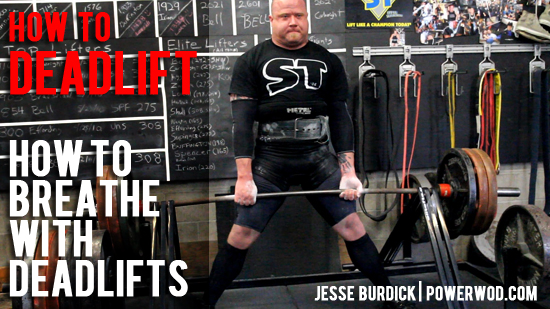
In our next installment from Jesse Burdick (PowerWOD.com), Jesse talks about one of the biggest issues when lifters are try to learn how to deadlift. How to set the core and learn how to breathe correctly, especially when you’re in the setup and restricted (compressed), can be very confusing.
If you have checked out our Hard:CORE system, you’ll know that breathing correctly is the key to setting your ‘inner core’ – and then has to happen if you want to create foundational stability. If we can create more stability, we will be able to create more tension and move with control. You can imagine this is pretty important when you’re pulling heavy weights off the floor.
Let’s see what Jesse has to say?
Side Note: To view the entire series, check out the Diesel Training Center
Breathing and Bracing for the Deadlift
Jesse states that breathing correctly is “important if you are missing off the floor and is used in conjunction with taking the slack out of the bar.” (see Jesse’s previous tip)
To brace correctly, you want to “imagine you have to brace for a punch.” This is the type of tension (irradiation=full body tension, engagement of multiple muscle groups or intermuscular coordination) you need for the bottom of the deadlift. This means you have to stay really tight when you setup to pull a deadlift and your breath starts this process.
By breathing correctly, you will:
– keep things tight
– protect your spine
– “wind up and set the spring”
So where does breathing factor into the deadlift setup?
When and Where to Breathe?
The problem with trying to get your breath in the hole (at the bottom of the deadlift, when you setup to pull the weight) is that your body is compressed. In this position breathing or catching a deep breath can be difficult. You can’t expand your abdomen and properly set your tension.
Jesse states that the two best times to breathe are:
1. Breathe at the Top – (when you’re standing up) and then drop down to grab the bar – this technique is reserved for more advanced lifters who have their technique dialed in
2. Breathe at the Bottom But in a Better Position – you’ll want to grab the bar first and then breathe – with your hips high and while you have more space – then drop into place “setting the spring” and creating tension. Then you pull the weight. I actually talk about this same technique in my popular How to Deadlift video. For a good visual explanation on how to use this breathing sequence, check it out HERE.
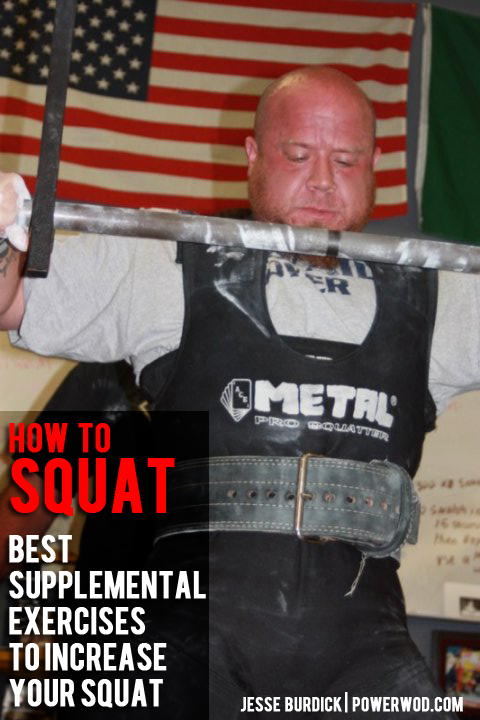
In our next installment from Jesse Burdick (PowerWOD.com), Jesse transitions from the bench press and deadlift to the squat. Laying the foundation by learning the fundamental squatting movement is the key before you even think of loading the movement. As you remember in my Simple Squat Progression article, I show you how to easily learn the movement through a series of simple progressions.
Let’s see what Jesse has to say?
Side Note: To view the entire series, check out the Diesel Training Center
Best Exercises to Build the Squat
1. Good Mornings – teaching the “hip hinge“. But we’re not just talking about the hinge, we’re talking about hinging with a straight torso, under load. So there is core bracing, stability and breathing, along with coordinating the upper (lats, core, erectors) AND lower (glutes, hamstrings, calves) posterior chain. There are lots of good morning variations, including: various barbells (SSB, cambered bar, giant camber, spider), suspended from chains or straps, sumo or conventional stance.
Editor’s Note: Many lifter’s perform good mornings with bad form or with too much weight. The ride the bar too high on their neck and they come up on their toes as they hinge in half. Put the bar placement lower to maximize your mechanical advantage and keep the weight on your heels – this will load the posterior chain. Stick to the basics and develop a good hinging pattern without rushing to overload the movement. Many exercises teach the hip hinge like kb swings, RDL’s, and basic movements like wall squats. But one of my favorites is the sumo stance Romanian deadlifts. Moving to a wider stance for this standard movement really teaches the lifter how to distribute the weight across their hips, glutes and entire posterior chain. It also forces them to really ‘pull the bar into their shins’ to keep the bar close and the lift safe.
One other important coaching progression is slowing down the movement to reinforce the pattern. As I showed in the recent Controlling Tempo article, increasing the duration of the eccentric phase of the RDL’s provided the athlete with numerous benefits including bracing proficiency, deceleration strength potential and more control.
2. Heavy Ab Work – core training is key to remaining stable and tight. Jesse recommends weighted sit-ups and side bends. At Diesel, we really like the weighted ab roller. It teaches and reinforces the hip hinge and creates really amazing core stability. Some things to look for are, can the athlete maintain a straight and neutral spine? For a visual reference, imagine the athlete has a dowel rod on their back. Are they maintaining three points of contact; head, upper back, and sacrum – with the dowel rod? The athlete will also need to learn how to tighten up and brace during both phases of the movement. Take a deep diaphramatic or belly breath, tighten up and tense every muscle, and then perform the movement. Finally, the athlete will need to learn how to pull with their lats to not only drive back into hip flexion, but also to decelerate hip extension. Remember, we’re thinking globally.
Weighted Ab Roller
If you have checked out our Hard:CORE system, you’ll know that breathing AND bracing correctly is the key to create real world core stability. If we can create more stability, we will be able to create more tension and move with control. You can imagine this is pretty important when you’re squatting heavy weights.
3. Hip Mobility Work – open the hips up and get the ‘side ass’ working. I can’t tell you how many articles I’ve written on various techniques for improving your hip mobility and glute activation. Most of us are limited in our movement at the hips and if you train on a regular basis, it is a constant battle to keep you moving without restriction. Sweep the Leg (you didn’t know I was in Karate Kid did you?), and The Perfect Lower Body Sequence, both showed two really good flows to open the hips up. (check out AMPED Warm-up for a complete ‘better movement’ system and how to incorporate more mobility into every workout)
Additional References:
Simple Squat Progression
https://www.dieselsc.com/how-to-build-strength-simple-squat-progression/
Learning the Hip Hinge
https://www.dieselsc.com/learning-the-hip-hinge/
Better Hip Hinge – Learning to Pull the Bar in and Use Lats
http://www.youtube.com/watch?v=QmO86A2gXMI
Better Hip Mobility – Sweep the Leg
https://www.dieselsc.com/awesome-hip-mobility-drill-sweep-the-leg/
Better Hip Mobility – Great Combo Sequence for Warming Up the Lower Body
https://www.dieselsc.com/how-to-warm-up-the-perfect-lower-body-warm-up-sequence/
How to Spot for Squats
https://www.dieselsc.com/how-to-squat-how-to-spot-the-squat/
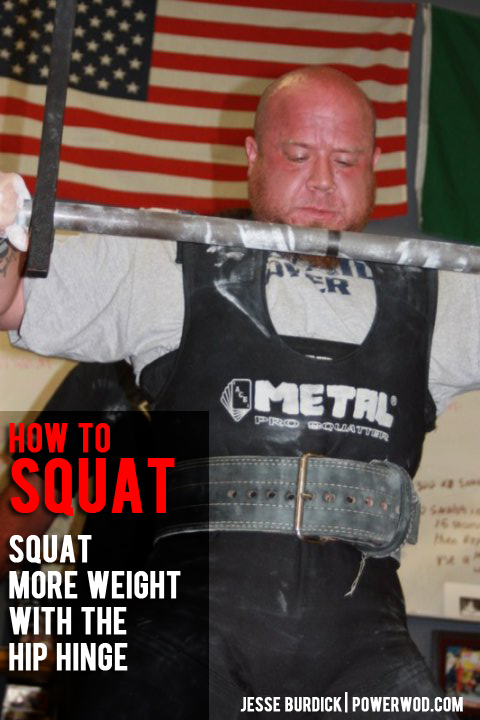
In Jesse’s last ‘How to Squat’ video, he talked about his top exercises for building a bigger squat. In this next installment from Jesse Burdick (PowerWOD.com), he focuses on one of the biggest mistakes that most lifters make when they squat. Instead of using their big lower body musculature correctly and distributing the weight, many novice squatters think they should just lower straight down. This is not only inefficient, it will likely stress their ankles, knees and low back.
Let’s see what Jesse has to say?
Side Note: To view the entire series, check out the Diesel Training Center
How to Bench Press | How to Deadlift | How to Squat | Simple Squat Progression
The First Move for Squats (Important)
Instead of squatting straight down or moving first at the knees (flexion), Jesse states that you should first hinge at the hips backward.
Most times the lifter is “thinking too much north / side (straight up and down) and not enough east / west (hip hinging to load the posterior chain).
Why is hip hinging important?
It gets “the weight distributed across your hips, glutes, and hamstrings.”
Best Way to Hip Hinge
Jesse states that the most common cues to move the lifter into the hip hinge correctly are “sit back, back, back”, “knees out, knees out”, and “spread the floor.” These are all great, but if you don’t know how to hip hinge, the cues will seems like nonsense.
How do you hip hinge correctly?
Step 1: Before any movement occurs, “stay tight and create lots of full body tension.” This will ensure you “load the spring as you descend.” Getting tight is referred as irradiation (in the RKC) and is a combination of breathing and flexing all of your muscles tight as hell.
Step 2: Slide the hips back and turn on your “side ass” on by spreading the floor and pushing your knees out.
Step 3: “Keep your torso upright and stay tall.” Your goal is to remain tight in the core and “move the weight with your hips and hamstrings; not your lower back.” Which happens when you lose position and fall forward in the hole.
By Smitty on June 1st, 2012
FREE DIESEL NEWSLETTER
- Discover Pain Free, Joint-Friendly Training
- Get Super Effective Workouts and Programs
- Inspirational Life Lessons Each Week
- Effective Habits For Busy Entrepreneurs



